Scientific Classification
Species in the Genus
Species in Kenya, Tanzania & Uganda
Description
Possible Causes of Confusion
Distribution in Kenya, Tanzania & Uganda
Habitats
Nesting
Crops Visited
Other Plants Visited
Economic / Ecological Importance
Threats
Conservation and Management Practices
Legislation (National and International)
References
Editors
Acknowledgements
Contact
Click on images to enlarge

Megachile species. © Bernhard Jacobi
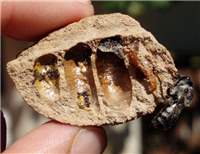
Megachile species and nest (in cross-section). Photo by Isidro Martínez (CC BY-NC-SA)

Megachile species. Photo by J. C. Lucier (CC BY-NC)
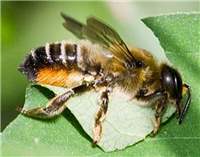
Megachile centuncularis cutting a leaf. Photo by Bernhard Plank (CC BY-SA)
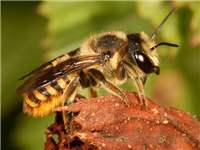
Megachile bee. Photo by Stanislav Krejcík (CC BY)
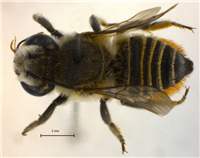
Megachile frontalis (female) - pinned specimen. Photo: Connal Eardley
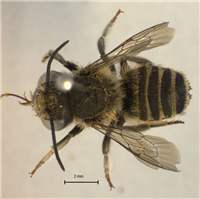
Megachile frontalis (male) - pinned specimen. Photo: Connal Eardley
Summary
Honey bees are not the only bee species that are significant for human wellbeing. Megachile bees are a group of native bee species that do not produce honey but are important pollinators of crops and wild plants. Megachile bees are not aggressive but can sting for defence. They have a mild sting that is much less painful than that of a honey bee. They live independently of others (i.e. they are solitary). Most Megachile bee species nest in sheltered locations in pre-existing natural cavities such as burrows, crevices and hollow twigs. These medium-small sized bees have a varied appearance, ranging from having pale bands of hair across the abdomen to black and orange. Females of most species have large mandibles (“jaws�?) for cutting leaves and flowers that they use to build their nests. This is the reason that many species of Megachile bees are known as leafcutter bees. The other group of Megachile bees (dauber bees) build their nests using mud instead of leaves. This fact sheet provides information about these bees to encourage farmers to understand and protect them to help ensure that their crops are effectively pollinated.
From a conservation and agricultural standpoint it is not necessary to recognise all the different bee genera. However, it is important to know that there is a large bee biodiversity. Different bee genera pollinate different plant species, although there is some overlap that acts as a buffer as bee populations wax and wane. For healthy ecosystems, including agro-ecosystems both diversity and abundance in the bee fauna is important.
Common Name (Language)
Leafcutter bees, dauber bees (English)
Scientific Classification
Kingdom: Animalia
Phylum: Arthropoda
Class: Insecta
Order: Hymenoptera
Family: Megachilidae
Subfamily: Megachilinae
Tribe: Megachilini
Genus: Megachile Latreille, 1802
Species in the Genus
The genus Megachile is a group of solitary bees. Megachile is one of the largest genera of bees, with more than 1,500 species found throughout the world.
Species in Kenya, Tanzania & Uganda
More than 100 described Megachile species occur in Kenya, Tanzania and Uganda (Eardley and Urban 2010). Thorough surveys from representative ecosystems are needed to establish what East Africa has in terms of Megachile species diversity.
Description
Megachile bees are not well known by local people (including farmers) in East Africa. These insects are usually not recognised as bees by local people in East Africa, where the name bee is generally thought only to apply to honey bees. Many Megachile bees have a greyish appearance due to the presence of pale hairs over a black cuticle. Pale bands of hair across the abdomen are common. The Megachile bees in East Africa vary from 9 – 22 mm in length. Females of most species have large mandibles (“jaws�?) for cutting leaves and flowers that they use to build their nests. Megachile bees have no sticky pads (arolia ) between their claws and therefore cannot climb smooth walls and glass.
Possible Causes of Confusion
Some insect species, such as other bees, beetles and flies can be mistaken for Megachile bees. Many people confuse Megachile bees with honey bees. However, they can be easily distinguished by observing their behaviour. Megachile bees carry their pollen under the abdomen and cut leaves to form their nests and do not live in colonies as honey bees do. The bee genera Ceratina (small carpenter bees), Xylocopa (carpenter bees), and Halictus (sweat bees) can also be mistaken for Megachile bees but differ in that they carry their pollen in hairy brushes on their hind legs. Flies can be distinguished from Megachile bees as they have only two wings while bees have four wings. Some ground beetles and ladybeetles can also be confused with Megachile bees. Beetles have hardened fore-wings (elytra ) while bees have four membranous wings.
Distribution in Kenya, Tanzania & Uganda
Megachile bees are found in most districts/regions of Kenya, Tanzania and Uganda.
Habitats
Megachile bees can be found in various habitats (land-uses) in East Africa such as grasslands, natural forests, marshlands, protected areas, farmlands, rangelands, woodlands, woodlots (forest plantations), along river edges (riparian areas) and in coastal areas.
Nesting
Megachile bees live independently of others (i.e. they are solitary). There are two nesting behaviours among Megachile bees. In the leafcutter bees, females neatly cut pieces of leaves or petals to build their nests, hence their common name. Most leafcutter bee species nest in sheltered locations in pre-existing natural cavities such as burrows, crevices and hollow twigs in any of the habitats listed above. The bees partition their nests with pieces of cut leaf which they typically construct a single long column of cells. Daubers use mud instead of leaves, and also sometimes build exposed nests that look like a ball of mud on a twig.
Crops Visited
Megachile bees are efficient pollinators of a variety of flowering crop species belonging to different plant families in East Africa. These include cucurbits, sunflower, eggplant, mango, avocado, watermelon, beans, coffee and cowpeas. Leafcutter bees are being domesticated in North America to pollinate alfalfa in open fields. No attempts have been made to domesticate leafcutter bees in East Africa.
Other Plants Visited
Megachile bees occurring in East Africa visit a range of wild plant species (trees, shrubs, herbs, weeds, lianas, grasses) in different habitats, especially plants with small greenish to whitish flowers. Some plants visited provide only building structures for the leafcutter bee nests.
Economic / Ecological Importance
Little information exists on the usefulness of these bees to the lives of the people in
Threats
In East Africa, Megachile bees and other bee taxa are threatened by factors such as habitat degradation, agricultural intensification (e.g. replacing hedges with barbed wire fences, and increased use of herbicides which can affect wild flower numbers), the misuse of insecticides and the collection of dry wood. Megachile bee populations in East Africa are likely to be affected by pests and diseases but information on this subject is lacking. Farming practices that involve over-digging of soils are likely to threaten populations of these bees since they often nest in underground burrows. The lack of knowledge of about these bees and their economic importance by people (de facto custodians of nature) is significant as their conservation and management practices implemented at the farm level will depend to a large extent upon the value that people attach to them.
Conservation and Management Practices
There are now concerted research efforts in the region to develop best practices for conservation and management of bees that are compatible with other good farm practices, to enhance crop production. Theoretically, bee conservation and management is inexpensive and adopted activities can also improve the aesthetic value of the landscape. Such practices involve setting land aside (e.g. a 1-metre strip) in the farmland to host all year round food resources for the bees, as well as safer sites for nesting, mating, resting and hiding from natural enemies. During flowering, farmers should manage pesticide usage carefully to avoid poisoning flower-visiting bees. Farmers should also minimise pesticide drift from the field to adjacent areas. Laws governing registration and use of plant protection products indirectly play a major role in the protection of pollinators. Trampling by people and livestock and tilling should be managed to conserve the nesting sites of those species that nest in burrows. Leafcutters need a supply of plants from which to collect nesting material and daubers need a source of mud and resin. KARI (the Kenya Agricultural Research Institute) is developing protocols for mass rearing of different species of solitary bees. Any successful results from this research will be freely communicated to the public. In addition, KARI is collaborating with other stakeholders to ensure in situ conservation and management of bees for pollination purposes. Much of the work of conserving native bees will be underpinned by raising public awareness of the importance of these species.
Legislation (National and International)
There is not yet any legislation in
References
1. Eardley CD, Gikungu M and Schwarz MP (2009) Bee conservation in Sub-Saharan Africa and Madagascar: diversity, status and threats. Apidologie, 40: 355–366.
2. Eardley CD and Urban R (2010) Catalogue of Afrotropical bees (Hymenoptera: Apoidea: Apiformes). Zootaxa, 2455: 1–548.
3. Michener CD (2007) The Bees of the world, the John Hopkins University Press, Baltimore and London, pp 913.
4. Pasteels JJ (1965) Révision des Megachilidae (Hymenoptera Apoidea) de l'Afrique Noire. I. Les genres Creightonella, Chalicodoma et Megachile (s.str.). Musée royal de l'Afrique centrale, Tervuren. Annales Sciences zoologiques, 137: 579pp.
Editors
Théodore Munyuli, Busitema University - Uganda; Muo Kasina, Kenya Agricultural Research Institute (KARI) - Kenya; Juma Lossini, Tropical Pesticides Research Institute (TPRI) – Tanzania; John Mauremootoo, BioNET-INTERNATIONAL Secretariat – UK; Connal Eardley, Plant Protection Research Institute (PPRI) – South Africa.
Acknowledgements
We recognise the support from the Kenya Agricultural Research Institute (KARI), Tropical Pesticide Research Institute (TPRI) –
Contact
BioNET-EAFRINET regional coordinator: [email protected]












